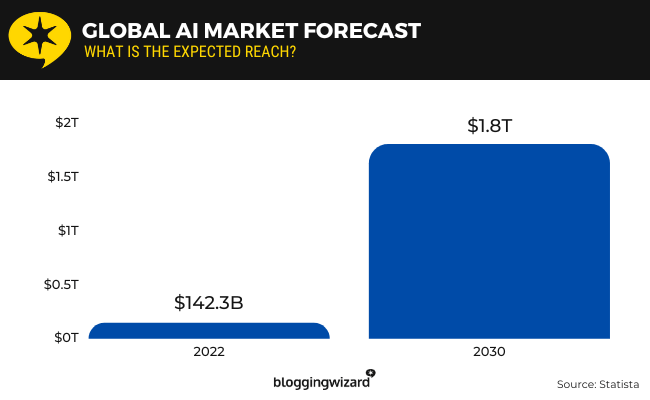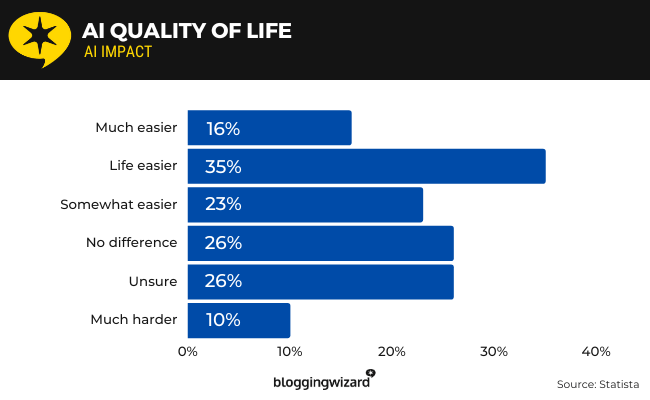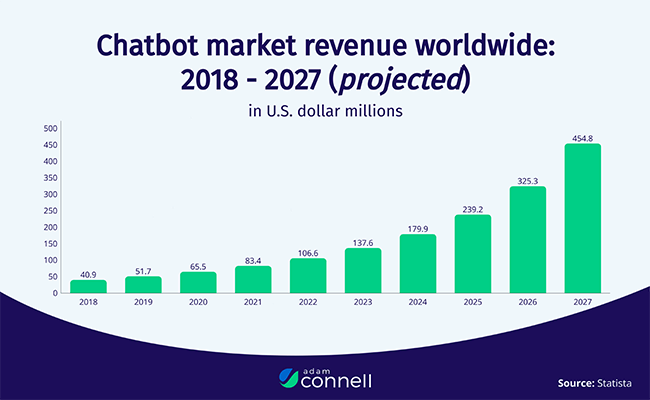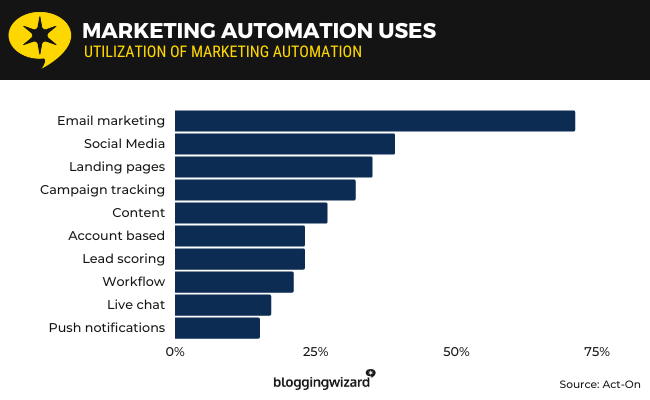23 Artificial Intelligence Statistics & Facts (2024 Data)

Are you on the lookout for artificial intelligence facts and statistics?
Artificial intelligence (AI) isn’t a new technology. It’s been around for a while, but its popularity has surged considerably in recent years.
We have quite a few interesting AI statistics on AI adoption, generative AI technologies, chatbots, and ways businesses may or would like to use AI in the future.
Artificial intelligence statistics – editor’s picks
Here are our top artificial intelligence stats:
- The global value of the AI industry will reach $1.8 trillion by 2030. (Statista)
- 63% of companies see an increase in revenue after adopting AI. (McKinsey & Company)
- 24% of companies use AI to optimize their service operations. (McKinsey & Company)
- 37% of Americans are worried about AI replacing jobs. (Statista)
- 87.2% of consumers who have used chatbots have had positive experiences with them. (Drift)
Key AI statistics
1. Artificial intelligence saw a dramatic increase in interest worldwide on Google beginning in December of 2022
Artificial intelligence growth is on the rise.
The topic “artificial intelligence” saw a sharp increase in popularity in December of 2022, according to Google Trends.
This coincided with the launch of OpenAI’s ChatGPT on November 30 of 2022.
Interest has been growing at a rapid rate worldwide ever since.

Interest is highest in China, Vietnam, South Korea, Romania and Taiwan.
Interest is lowest in Turkey, Russia, Iran and France.
Interest is on the decline in the United States.

Source: Google Trends
2. The global artificial intelligence market size is worth $142.3 billion
According to data published by Statista in cooperation with Next Move Strategy Consulting, the global AI market size was valued at $142.3 billion in 2022.

This number is expected to reach $1.8 trillion by 2030.
Source: Statista1
3. The explainable artificial intelligence market size will reach $21 billion by 2030
Statista’s market data on artificial intelligence, which includes data on explainable AI or XAI, reveals that the global market size for this form of AI was $4.4 billion in 2021 and will reach $21 billion by 2030.

XAI is AI that can “show its work,” so to speak.
That is, it’s artificial intelligence that’s capable of showing how it arrived at a particular response, such as a medical diagnosis.
Source: Statista2
4. The market size for AI-driven robots will reach $77.7 billion by 2030
Statista’s data on the AI-driven robot market, which they published in cooperation with Next Move Strategy Consulting, reveals that the market size for this form of AI will reach $77.7 billion by 2030.
It was $9.3 billion in 2022.

An example of an AI-driven robot is Starship Technologies’ autonomous delivery robots.
The Starship robots in particular are equipped with sensors and AI mapping that help them navigate themselves to their destinations, and then return.
Source: Statista3
5. Baidu is the largest owner of AI patents at 13,993 active patent families
Statista publishes data on patent owners who own patents for machine learning and artificial intelligence technologies.
The data is published in cooperation with LexisNexis and PatentSight.
It reveals Baidu as the leading owner of AI-specific patents. They own 13,993 active patent families.

In second is Tencent, who own 13,187 active patent families.
Source: Statista4
AI adoption statistics
6. 63% of companies who adopt AI see an increase in revenue
McKinsey & Company’s survey of companies who have adopted AI revealed that 63% of companies see revenue increases after adopting AI and 32% see cost decreases.
Revenue increases are mostly reported in the marketing and sales and product/service development departments at 70 and 70% respectively.
Cost decreases are mostly reported in supply chain management as 52% of companies have reported seeing cost decreases in this department.
Source: McKinsey & Company
7. Companies have an average of 3.8 AI systems embedded into their organizations
McKinsey & Company have been conducting a survey on AI every year since 2018.
In 2022’s edition of the survey, they discovered that companies have an average number of 3.8 AI capabilities embedded into their organizations’ processes.
While this is down by 0.1 from 2021, it’s up by 1.9 from 2018’s number of 1.9.
Here are the top five AI capabilities companies have integrated into their systems:
- Robotic process automation – 39% of survey respondents say their organizations have integrated this AI capability.
- Computer vision – 34%
- Natural-language text understanding – 33%
- Virtual agents or conversational interfaces – 33%
- Deep learning – 30%

It’s important to note that this follow up question was only asked of respondents who stated their companies have integrated at least one AI capability into their organizations.
Source: McKinsey & Company
8. 24% of companies use AI for service operations optimization
When McKinsey & Company asked companies who use AI about their AI usage, 24% of respondents say their organizations use AI for service operations optimization.

20% use AI to create AI-based products, 19% use it for customer service analytics, another 19% use it for customer segmentation and yet another 19% use it to implement AI-based enhancements to products.
Source: McKinsey & Company
9. 51% of companies who adopt AI are mostly concerned about cyber security risks
McKinsey & Company asked companies who have adopted AI what they consider to be the biggest risks of implementing this technology into their systems.
51% chose cyber security, 36% chose regulatory compliance, 28% chose personal privacy, 22% chose explainability and another 22% chose organizational reputation.

Source: McKinsey & Company
10. 37% of Americans think AI will lead to fewer jobs
A survey published by Statista in cooperation with YouGov, which had 4,021 respondents, revealed that the majority of Americans aren’t sure if AI will lead to more or fewer jobs.
Americans over the age of 65 make up the age group who is most unsure about AI’s potential in the job market.

However, most Americans agree that AI will lead to fewer jobs with 19% saying it’ll lead to somewhat fewer jobs and 18% saying AI will lead to many fewer jobs.
12% think AI will lead to somewhat more jobs while 13% think it’ll lead to many more jobs.
The age group most concerned about AI’s influence on the workforce are individuals aged 45-64 years old, 29% of whom think AI will lead to many fewer jobs.
When we combine these numbers, we get the following stats:
- 37% of Americans think AI will lead to fewer jobs.
- 25% think AI will lead to more jobs.
- 18% think the number of jobs available will remain the same.
- 20% are unsure.
According to McKinsey & Company’s survey, companies implemented AI-related roles by hiring employees with the following job titles in 2021:
- Software engineer – 39% of companies who have adopted AI hired software engineers in AI-related roles in 2021.
- Data engineers – 35%
- AI data scientists – 33%
- Machine learning engineers – 30%

Source: Statista5
11. 35% of Americans say AI makes life easier
In the survey conducted by YouGov and Statista, which had 4,021 respondents, the pair discovered that 35% of Americans say AI makes life easier with 23% saying it makes life somewhat easier and 16% saying it makes life much easier.

26% don’t think AI makes much of a difference in the lives of Americans while another 26% are unsure.
However, only 10% of respondents think AI makes life harder.
Source: Statista6
12. Only 31% of companies in North America are working to reduce their carbon emissions from AI use
McKinsey & Company asked companies who have adopted AI about their sustainability practices in regards to the technology.
They found that only 31% of North American companies who have adopted AI are taking steps to reduce their carbon emissions from using the technology.

In comparison, 53% of companies in developing markets, 47% of Asian-Pacific, 46% of Chinese and 36% of European companies are taking steps to reduce their carbon emissions from AI use.
Here’s the regional breakdown of companies are using AI in their sustainability efforts:
- Greater China – 61% of companies in this region are using AI in their sustainability efforts.
- Asia-Pacific – 54%
- Developing Markets – 44%
- Europe – 39%
- North America – 30%
Source: McKinsey & Company
Generative artificial intelligence statistics
13. Only 14% of adults in the United States have tried ChatGPT
Pew Research Center surveyed 10,701 adults in the United States about their familiarity with Open AI’s generative AI tool ChatGPT.
They discovered that despite 57% of adults in the United States having heard of ChatGPT, only 14% have tried it.
Of those that tried it, 19% used it for entertainment, 14% used it just to try something new and 12% used it for work purposes.
Of those that tried ChatGPT, 56% said they found the technology to be useful.
39% said it was somewhat useful, 20% said it was very useful and 15% said it was extremely useful.
On the other end of the scale, 21% said it was not too useful and 6% said it wasn’t useful at all.
Source: Pew Research Center
14. Generative AI is mostly being adopted by marketing and advertising companies at a rate of 37%
In a survey published by Statista, which had 4,500 respondents, it was revealed that 37% of marketing and advertising companies have adopted generative AI technology in the workplace, the most of any industry.

35% of tech companies have adopted generative AI while 30% of consulting companies, 19% of teaching institutions, 16% of accounting companies and 15% of healthcare organizations have integrated it into their systems.
But exactly how these companies are integrating AI is unclear. It’s doubtful that AI is completely replacing writers but there have been some reports of certain companies cutting back on staff levels.
In our opinion, this is not the best choice given that AI gets a lot of facts wrong and requires fact checking. This is why we believe the best use of generative AI is as an assistant to writers rather than a replacement for them.
It all comes down to workflow. And AI rewriter tools can definitely help writers speed up their workflow. It’s particularly useful for overcoming writer’s block.
Source: Statista7
15. Bing is the second most popular search engine with a market share of 2.77% globally on all platforms
Statcounter keeps track of the global market share for the world’s most popular search engines: Google, Microsoft’s Bing, Yandex, Yahoo!, DuckDuckGo and Baidu.
Google has the highest market share at 93.12% with all other search engines falling behind at 2.77% (Bing), 1.15% (Yandex), 1.11% (Yahoo!), 0.51% (DuckDuckGo) and 0.49% (Baidu).

Bing is most popular in North America where its market share is 5.79%.
Its market share in the United States is 6.35%.
Worldwide, its market share is highest on desktop, which is likely due to its integration with Microsoft’s Windows operating system.
The search engine’s market share is even higher on desktop and tablet devices in the United States where its market shares are 12.51% and 12.82% respectively.
The reason we bring this stat up is simple: Microsoft has integrated its search engine, Bing, with the ever-popular AI tool ChatGPT and have even included technology from AI-powered voice assistants.
Prior to this integration, Microsoft had been a key investor of ChatGPT’s developer OpenAI.
With Bing spending much of its 10+ years of existence lagging behind Google’s search engine, many are curious to see if ChatGPT can finally help the search engine become a true competitor for Google.
And in case you’re wondering, according to Statcounter’s data, Google’s Chrome browser, whose default search engine is Google, has a market share of 62.85% worldwide.
Microsoft’s Edge browser, whose default search engine is Bing, has a market share of 5.31%.
This puts Bing in third place behind Apple’s Safari browser, which has a market share of 20.72%.
Source: Statcounter
Note: You can find more stats in our dedicated article on generative AI statistics.
AI-adjacent statistics
16. The chatbot market value will reach $454.8 million by 2027
According to data published by Statista, the global market value for the chatbot industry will reach $454.8 million by 2027, up from $40.9 million in 2018.

Source: Adam Connell
This rapid growth rate is due to chatbots being the fastest-growing form of customer communication for brands.
In 2019, 13% of brands used chatbots. This number grew to 24.9% by 2020.

Source: Adam Connell
All other forms of communication experienced a more subtle growth rate, except for phone and video calls, which saw a dramatic decrease of 15.7%.
Source: Statista8, Drift
17. 87.2% of consumers have had positive experiences with chatbots
When Drift surveyed consumers about their experiences with chatbots, they found that 87.2% of consumers reported having positive experiences with chatbots while only 12.8% of consumers have had mostly negative experiences.

Source: Startup Bonsai
Even so, 60% of respondents in a survey conducted by Userlike said they’d prefer to wait to speak with a human customer representative than to have a chatbot respond immediately.
However, the survey also revealed that the majority of consumers would “definitely” use a chatbot initially in order to be transferred to a human customer service representative.
As far as what consumers like about chatbots, 68% of consumers like how quick they respond.

Source: Startup Bonsai
Other popular options chosen in the survey were “the chatbot was used to transfer you to a human agent who could better assist you” and “the chatbot could help me outside of normal service hours.”
Less than 20% of respondents said chatbots understood their questions well.
Source: Drift, Userlike
18. ASAPP is the most-funded startup in the chatbot/conversational AI category
ASAPP has received more than $380 million in funding, almost twice the amount of the company in second place, Observe.ai, who have received $214 million in funding.

ASAPP’s technology has always been powered by AI, but now they’ve started to integrate generative AI systems into their technology.
The company powers the customer service divisions of JetBlue, Spectrum and Dish.
Source: Statista9
19. 83% of businesses with large marketing budgets use marketing automation heavily
Pedalix surveyed 460 B2B companies with a variety of different marketing budgets in 2022.
They discovered a correlation between how much of a company’s marketing strategy is powered by automation and how high that company’s marketing budget is.
83% of businesses with marketing budgets over $570,000 use marketing automation heavily, an increase of 2% from the previous year’s survey.
Furthermore, while big businesses are most likely to use marketing automation, the biggest adoption rate came from businesses with marketing budgets between $107,000 and $570,000.
81% of businesses in this range now use marketing automation compared to just 50% in 2021.
Only 59% of companies with marketing budgets below $107,000 use marketing automation, though this is up from 2021’s 44%.
Source: Pedalix
20. 26% of B2B businesses handle marketing automation on their own
Pedalix asked 460 B2B companies about specific aspects of marketing automation they may need third-party help with in the future.
The majority of companies (26%) plan on handling everything in house while 8% claim to not use marketing automation at all.
10% of companies prefer to use a full-service company that manages marketing automation for them.

Source: Blogging Wizard
Of those that do need external help with marketing automation, 22% need help with technology implementation, 16% need assistance with defining strategies and use cases, and 14% need help with implementing marketing automation campaigns.
Source: Pedalix
21. 62% of B2B companies use conversion rates to track the success of marketing automation campaigns
SaaS companies looking to implement AI technology as a marketing product or service need to know what their target market looks for in marketing technology.
Fortunately, we have an answer to this.
When Pedalix surveyed 460 B2B companies, they asked those companies how they measure the success of marketing campaigns implemented with automation.
62% use conversion rates, and 60% use the number of sales they received.
57% use the number of leads they received, and 51% use their return on investment.

Source: Blogging Wizard
Therefore, we conclude that SaaS companies producing AI-powered marketing products and services should make sure their products improve conversion rates and the number of sales received per campaign above all else.
Here are metrics marketers find least valuable when measuring the success of their company’s implementation of marketing automation:
- Email marketing metrics – Chosen by 38% of marketers
- Churn rate – 34%
- Website engagement – 33%
- Social media engagement – 24%
- Duration of the sales cycle – 21%
Source: Pedalix
22. 71% of marketers use marketing automation for email marketing
Act-On surveyed 160 marketing professionals and asked them about the aspects of marketing they use automation for.
71%, which was the majority, said they use automation for email marketing.
Less popular uses include social media marketing (used by 39% of marketers), landing pages (35%) and campaign tracking (32%).

Source: Blogging Wizard
Other use cases received the following votes:
- Content management – Chosen by 27% of marketers
- Account-based marketing – 23%
- Lead scoring – 23%
- Workflows and automation visualizations – 21%
- Live chat – 17%
- Push notifications – 15%
However, Act-On also asked marketers what they want to use marketing automation for.
In this regard, these same marketing aspects received the following votes:
- Social media – Chosen by 36% of marketers
- Email marketing – 36%
- Paid ads – 34%
- Campaign tracking – 31%
- Account-based marketing – 29%
- Landing pages – 29%
- Content management – 25%
- Live chat – 25%
- Lead scoring – 24%
What these numbers prove is that SaaS companies looking to develop AI systems for the marketing industry should align their products with how marketers are most likely to use these types of automated systems: to make email marketing and social media management more efficient.
Source: Act-On
23. 34% of content planners use automation for SEO purposes, such as keyword research
In HubSpot’s Content & Media Strategy report for 2023, the company asked content planners about the ways they use automation for content marketing.
34% use automation for SEO and keyword research as well as to generate ideas for content.
This number will likely increase as more and more SEOs and marketers start adopting AI to generate outlines for blog posts.

40% of content planners use automation to integrate key content marketing channels with one another.
37% use automation to distribute targeted content while 36% use it to share content to various social media platforms automatically.
32% use automation to distribute newsletters for content marketing campaigns.
Source: HubSpot
Artificial intelligence statistics sources
Final thoughts
That concludes our list of the latest artificial intelligence statistics.
Consumer opinions about AI aside, one thing’s for certain, and that’s AI is here to stay, especially as a business strategy so long as businesses continue to see cost decreases and revenue increases by implementing AI.
We’ll likely see more companies adopting AI in the future and more consumers adapting to it as time goes on.
Whatever the case may be, we’ll be sure to keep you posted on the latest artificial intelligence statistics.
Related reading:
